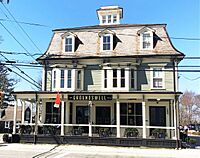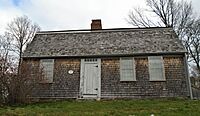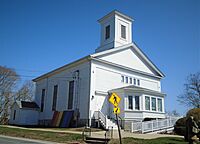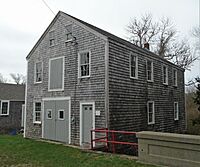Tiverton Four Corners Historic District facts for kids
Quick facts for kids |
|
|
Tiverton Four Corners Historic District
|
|
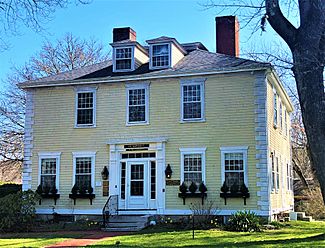
The Soule-Seabury Mansion (1809)
|
|
| Location | Tiverton, Rhode Island |
|---|---|
| Area | 50 acres (20 ha) |
| Architectural style | Colonial Greek Revival Victorian |
| NRHP reference No. | 74000042 |
| Added to NRHP | 1974 |
The Tiverton Four Corners Historic District is a special area in Tiverton, Rhode Island. It's like the heart of the old village. This district stretches along Main Road, both north and south. It includes the spot where Main Road meets East Road and Puncatest Neck Road.
This historic area covers about 50 acres (20 hectares). It has sixteen old buildings. Most of these buildings are houses from the 1700s and early 1800s. You can also find the Union Public Library, built in 1868. There are also old mill buildings near the Mill Pond and the A. P. White Store.
Contents
History of Tiverton Four Corners
Early Inhabitants and Land Use
Long ago, the Pocasset tribe lived in this area. Later, in 1637, two people named John Clarke and William Coddington bought Aquidneck Island. This island is across the Sakonnet River from where Tiverton is today. They bought it from the Narragansett tribe.
They also got permission from the Wampanoag tribe to use land on the eastern side of the river. This is the land where Tiverton Four Corners is now.
Settlement and Colonial Changes
Land grants were given out by Plymouth Colony as early as 1659. But the main development of the area didn't really start until around 1679. Plymouth Colony later became part of Massachusetts.
The people living in this area wanted to leave Massachusetts. They wanted to join the Colony of Rhode Island instead. This disagreement about which colony they belonged to lasted a long time. It wasn't finally settled until 1746.
Becoming a Historic Place
The Tiverton Four Corners Historic District was added to the National Register of Historic Places in 1974. This means it's recognized as a very important historical area. It helps protect the old buildings and the history of the village.
Gallery




